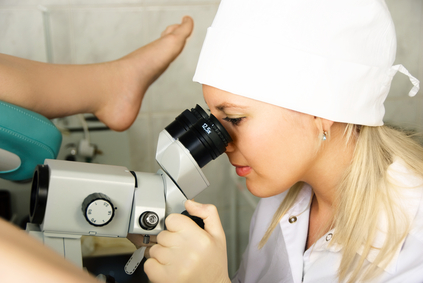Colposcopy For Abnormal Pap Smear

If you have ever gone through the fear of an abnormal Pap test, then you can appreciate why it is so important to get an annual Pap smear from your Raleigh OBGYN. If you have come to this page looking for more information, allow us to first tell you to not panic. It is easy to fall into a complete panic when dealing with the unknown. However the steps following an abnormal Pap smear are clearly laid out for you to get the quality care you need.
What is a Pap smear?
You may see a Pap smear referred to as a Pap test or cervical cytology screening. These tests allow for your gynecologist to see if there are any changes in the cells on your cervix. These changes will alert your doctor to know whether or not they will turn into cancer cells in the future. If you do, in fact, have an abnormal Pap smear, your next step will be a colposcopy.
What is a colposcopy?
A colposcopy is the process of looking at your cervix with a microscope. The microscope will allow the doctor to see cells that cannot be viewed with the naked eye. Your doctor may decide to do small biopsies from the areas where the abnormal cells appear. A biopsy is the removal of small pieces of tissue using special forceps that are examined under a microscope. If necessary, your doctor may order that a photo or video camera be attached to the forceps to gather more information about the state of your cervical health. A biopsy, of this kind, tends to be relatively painless. Once the biopsy is complete, a solution is placed on the area where the tissue was removed to encourage the healing process.
What are doctors looking for during a colposcopy?
When you are called in to do a colposcopy, your doctors are looking for viral infections as well as infections that are caused by bacteria, fungi, or protozoa. These can include any of the following:
-
HPV diagnosis or the human papillomavirus
-
genital warts
-
cervical cancer
-
cervicitis or inflammation of the cervix
-
precancerous tissue in the cervix
-
precancerous tissue in the vagina
-
precancerous tissue in the vulva
-
cancer of the vagina
-
cancer of the vulva
If you are close to menopause, it is a possibility that natural changes in the cervix due to atrophic vaginitis can cause an abnormal Pap test result. If abnormal cells are left untreated, there is a possibility that it can progress to precancerous or cancerous cells.
Is a colposcopy considered to be safe?
A colposcopy is considered to be a safe procedure with very few risks involved. Complications are rare, however if present, they may include heavy bleeding, infection, or pelvic pain. If after receiving a colposcopy you experience any one of the following symptoms, you should call your gynecologist immediately:
-
heavy bleeding that is much heavier than what you would experience during your menstrual cycle
-
chills
-
fever
-
severe pain in the abdomen
How should I prepare for my colposcopy?
Here are a few tips that will help you to be prepared for your colposcopy with the least amount of complication:
-
Do not schedule your colposcopy around the time of your menstrual cycle.
-
Refrain from engaging in vaginal sex for 24 to 48 hours before your exam.
-
Do not use tampons for 24 to 48 hours before your exam.
-
Try taking a mild, over-the-counter pain reliever like acetaminophen or ibuprofen before your exam.
How can I relieve anxiety before my colposcopy?
It is normal to feel anxious before a colposcopy. Perhaps you are finding it difficult to focus on your work or family. Perhaps you are having trouble falling asleep at night. However anxiety shows up for you, understand that this is a normal reaction. However research has shown that women with high anxiety experience more pain during their colposcopy procedure. Here are some relaxation tips to keep in mind prior to your procedure.
-
Write down any questions or concerns you have about the colposcopy or the potential results before the process begins.
-
Engage in activities you find relaxing: yoga, taking a walk in nature, enjoying family time, listening to music, etc.
